Teoksia käsintehdyille papereille, 2019
Works on handmade papers



2019
Aallokko
Käsintehty paperi hampusta ja puuvillasta, kivi, lanka
Teoksen koko: 43*56 cm
Jalustan koko:101*35*35 cm
Aallokko
Käsintehty paperi hampusta ja puuvillasta, kivi, lankaTeoksen koko: 43*56 cm
Jalustan koko:101*35*35 cm
2019
Surge
Handmade paper from hemp and cotton, rock, thread
Size of the work: 43*56 cm
Size of the stand: 101*35*35 cm
Surge
Handmade paper from hemp and cotton, rock, thread
Size of the work: 43*56 cm
Size of the stand: 101*35*35 cm

Vasemmalta:
Riutta, Virta, Saari
Riutta, Virta, Saari
From the left:
Reef, Stream, Island
Reef, Stream, Island
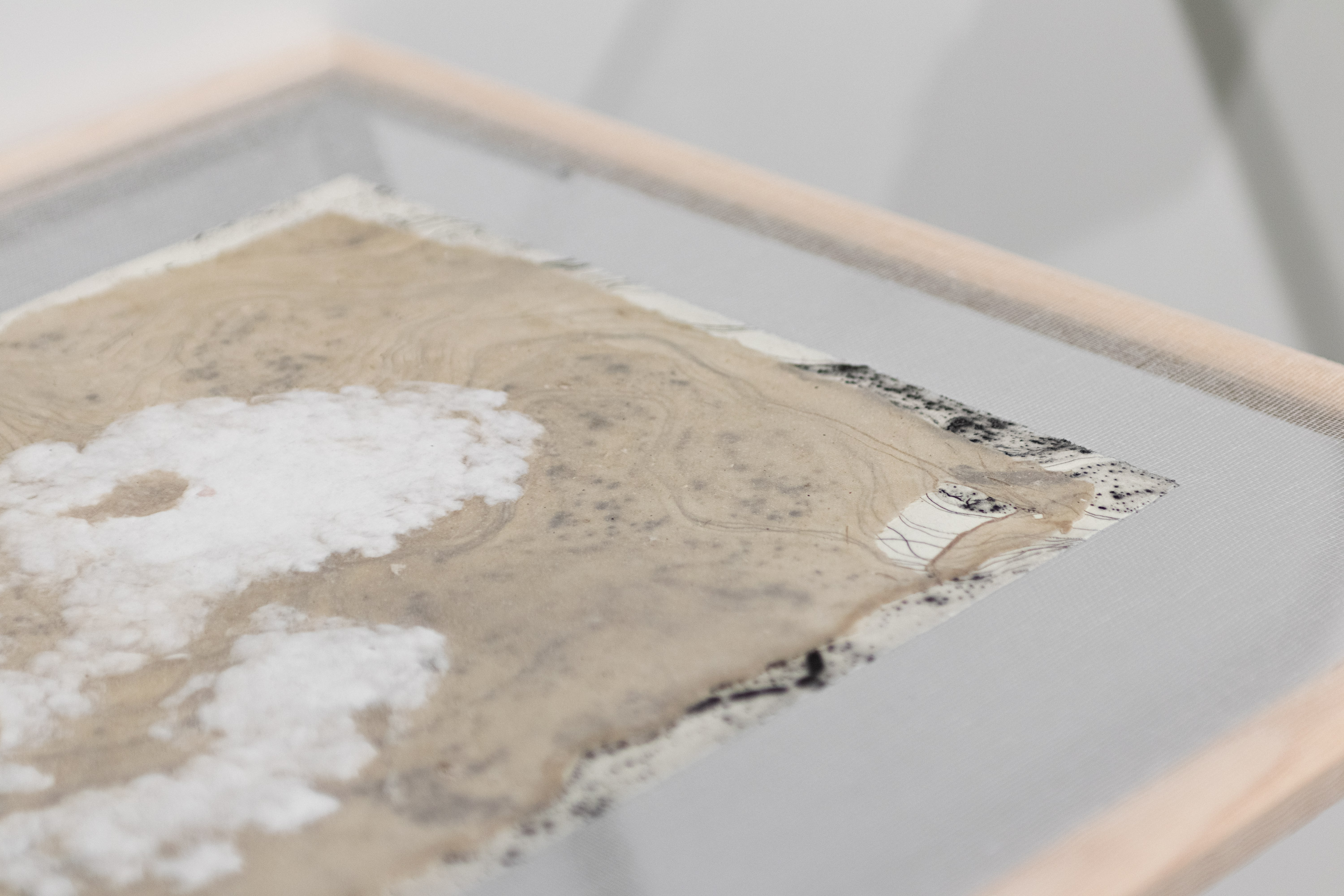
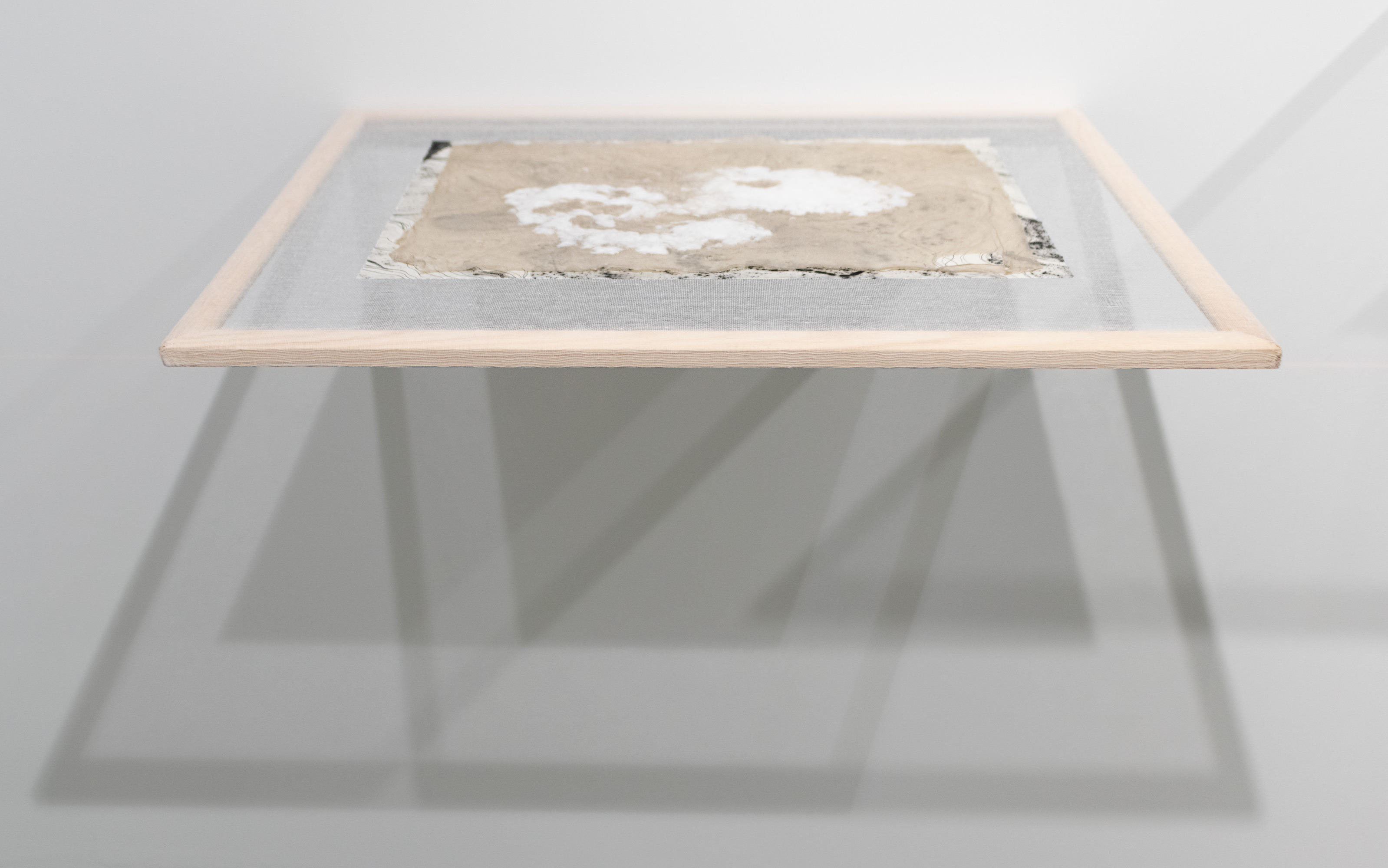
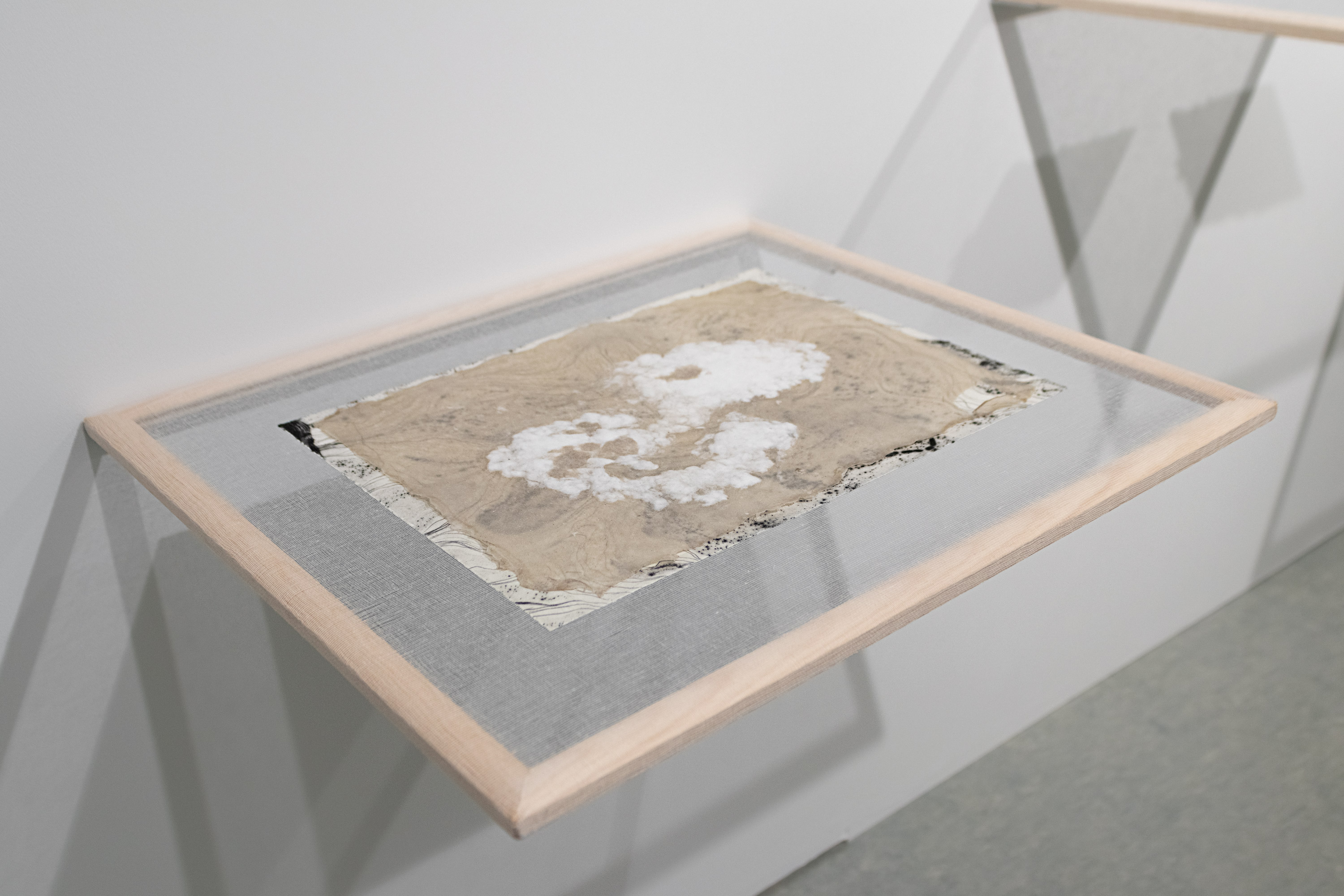


2019
Riutta
Käsintehty paperi hampusta ja puuvillasta, sideharso, puurima
Riutta
Käsintehty paperi hampusta ja puuvillasta, sideharso, puurima
2019
Reef
handmade paper from hemp and cotton, gauze, wood frame
Reef
handmade paper from hemp and cotton, gauze, wood frame
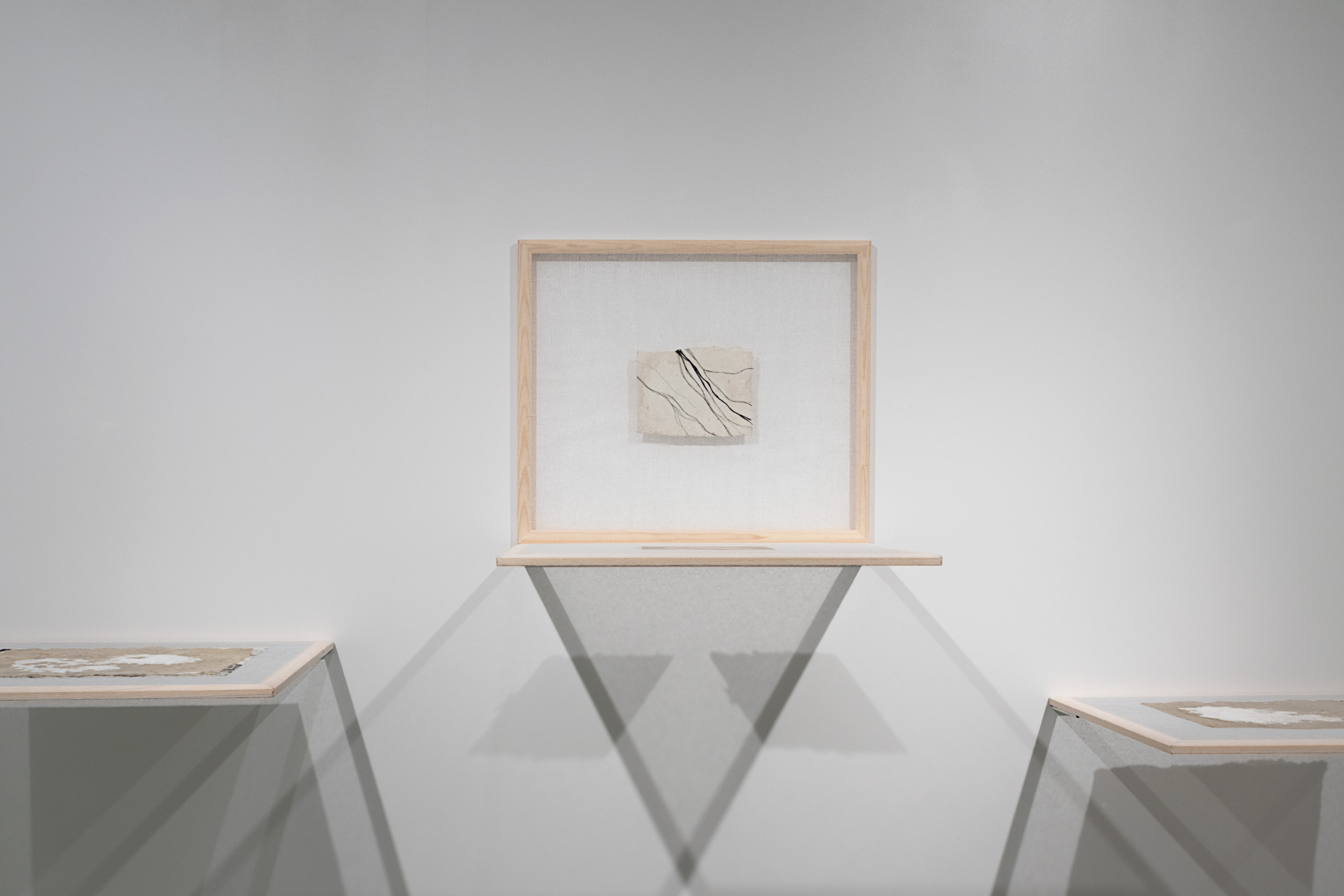


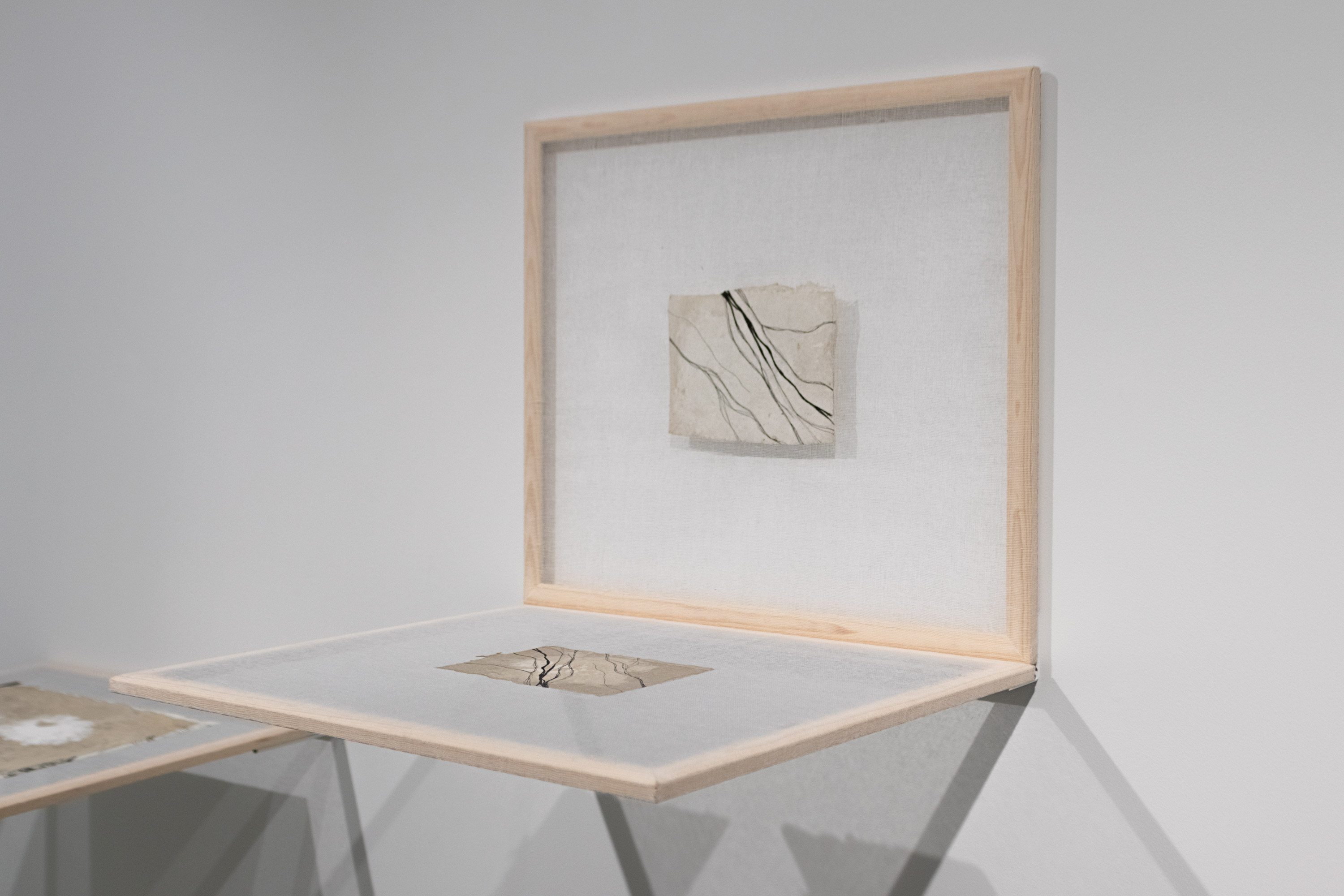

2019
Virta I & II
esitetty diptyykkinä
Käsintehty paperi hampusta ja puuvillasta, sideharso, puurima
Virta I & II
esitetty diptyykkinä
Käsintehty paperi hampusta ja puuvillasta, sideharso, puurima
2019
Stream I & II
diptych
Handmade paper from hemp and cotton, gauze, wood frame
Stream I & II
diptych
Handmade paper from hemp and cotton, gauze, wood frame
FIN
Vesi on edellytys elämälle ja niin myös taiteen tekemiselle. Teoksissani tutkin käsintehdyn paperin ominaisuuksia ja ihastelen veden ja paperimassan yhteistyön tuloksia. Tämä teossarja onkin eräänlainen kiitos vedelle.
Veden avulla olen valmistanut erikokoisia papereita kuituhampusta ja puuvillasta. Kuituhamppu on perinteinen viljelyskasvi jota on viljelty tuhansia vuosia ja Suomessakin se on ollut tärkeä materiaali mm. tekstiilituotannossa. Kuidusta valmistetaan nykyään esimerkiksi öljypohjaisia muoveja korvaavia biokomposiitteja sekä poltto-ominaisuuksiltaan puuta vastaavaa bioenergiaa[1]. Vaikka kuituhampulla ei olekaan päihdyttäviä ominaisuuksia, sitä viljelläkseen on Suomessa anottava erityislupa. http://www.hemprefine.fi/projects/kuituhamppu-lyhyesti →
Teokset esitetty seuraavissa näyttelyissä:
Graphica Creativa 2019 – Hereafter: 15. kansainvälinen taidegrafiikan triennaali, Jyväskylän taidemuseo, 27.9.–1.12.2019
EN
In this series I am studying the traits and features of handmade paper. As I was making the papers, I kept thinking about water and it’s role in making art. Streaming water, life-giving water that was so present when I produced these papers. What a privilege it was to be able to make these papers! It was possible because we have this seemingly endless resource in Finland. It feels like it’s a never ending stream and at the same time I realize this is not the case globally. Through these works I want to thank the water.
To make the papers, I have used both cotton and hemp fibers. Hemp has been farmed for its fiber for thousands of years around the world, including Finland. It can be refined into a variety of commercial items, including paper, textiles, clothing, biodegradable plastics, paint, insulation, biofuel, food, and animal feed[1]. Hemp is also a very controversial plant. Though fiber hemp does not have intoxicating properties, to farm it in Finland, you need a permit.
https://en.wikipedia.org/wiki/Hemp →
The works have been exhibited in:
Graphica Creativa 2019 – Hereafter: 15. International Print Triennial at Jyväskylä Art Museum, Finland, 27.9.–1.12.2019
Language of Belonging, group show, Exhibition Laboratory, Helsinki, Finland, 14.2.–8.3.2020
Graphica Creativa 2019 – Hereafter: 15. International Print Triennial at Jyväskylä Art Museum, Finland, 27.9.–1.12.2019
FIN
GRAPHICA CREATIVA
Graphica Creativa on pohjoismaiden vanhin ja ainoa säännöllisesti järjestettävä kansainvälinen grafiikkanäyttely Suomessa. Kolmen vuoden välein toistuvaa Graphica Creativaa on järjestetty Jyväskylässä vuodesta 1975 lähtien. Vuoden 2019 näyttelyn on tuottanut Jyväskylän taidemuseo ja sitä on tukenut Taiteen edistämiskeskus.
Graphica Creativa 2019 – Hereafter -näyttelyyn on kutsuttu taideyliopistot kolmesta maanosasta; Helsingistä, Oslosta, Tokiosta sekä Edmontonista, Kanadasta. Kukin yliopisto on valinnut omaan osioonsa ajankohtaisen teeman. Pääosassa ovat taidegrafiikan opiskelijat, jotka ovat tuottaneet näyttelyyn teemoista omat projektinsa. Opiskelijatöiden lisäksi esillä on professorien ja opettajien teoksia sekä Kuvataideakatemian opettajien yhteisteos Kuvitellut maisemat. Näyttelyn verkkosivustolle on koottu osallistuvat taiteilijat kunkin yliopiston teeman alle.
IN A STATE OF FLUX: WHAT NOW? WHERE ARE WE?
Taideyliopiston Kuvataideakatemian opiskelijat
Epävarmuus ja epävakaus on haastava lähtökohta. Kokonaisuuden In a State of Flux: What now? Where are we? teemana on ollut maailman tila. Se on toiminut lähtökohtana resursseja, materiaaleja, jätettä, ilmastomuutosta ja luonnon rakenteita käsittelevälle pohdiskelulle. Näemme kollektiivisen teoksemme dynaamisena ja kytkeytyneenä kokonaisuutena, jonka koossapitävänä voimana ovat viittaukset maapalloon ja sen sivutuotteisiin. Tutkimme muutosta ja olemme osa sitä niin yksilöinä kuin taiteilijoina.
Pohdimme taidegrafiikan kehityssuuntia ja omaa toimijuuttamme maailman todellisuuden jäljentäjinä. Teoksemme perustuvat paljolti näkemiseen, havaintoon ja materiaaleihin. Emilia Tannerin laserleikatut teokset tutkivat taiteen tekemistä valon ja näkemisen kautta lasersäteistä tietokonenäyttöihin, digitaalisiin laitteisiin ja katsovaan ihmissilmään. Hänen teoksensa muistuttavat meitä niistä lukuisista muunnoksista ja prosesseista, jotka kuva käy läpi ennen kuin se saavuttaa katsojan silmän. Linda Ciesielski tarkastelee jään muutoksia veneen ikkunasta. Itämerellä olevat kuviot nostavat esiin kysymyksiä epävarmuudesta ja havainnosta: jää maana, maa vedeksi muuttuvana. Ciesielski pohtii miten voisimme ymmärtää luontoa nopean muutoksen keskellä ja nähdä paikalliset ilmiöt osana jaettua globaalia kokemusta. Koiria metsässä ulkoiluttaessaan Aura Kotkavirta löytää yllättäen kevään valossa kylpevän korkean mäen, joka on mustan hiekan, outojen pensaiden ja purppuran peittämä. Koirat ihmettelevät, mikseivät ne saa juoda vettä läheisistä lätäköistä. Kotkavirta kuuntelee metsän täyttävää lintujen liverrystä ja oivaltaa miten romanttisen epätodellinen paikka on: kokonainen vuori väärään paikkaan joutunutta kaupungin lunta, sulamassa.
Emma Peura ja Maria Erikson ajattelevat käsillään ympärillään olevia materiaaleja: vettä ja paperia. Pidellessään paperipinoa, jonka arkit hän on tehnyt kuituhampusta ja puuvillasta, Emma Peura huomaa pohtivansa makeaa vettä, sen runsautta Suomessa – mikä etuoikeus – ja makean veden vähyyttä maailmassa. Emmalle grafiikan tekeminen antaa aikaa ajatella käsillä: materiaalien kanssa työskennellessä hän oivaltaa asioita omasta elämästään ja maailmasta. Maria Erikson tutkii töissään vettä ja käsintehtyä paperia materiaalisuuden ja ajan näkökulmasta. Hän haluaa määritellä uusiksi grafiikan subjektin ja objektin tutkimalla materiaalin muuntumista kontaktin ja kulumisen kautta, taiteen tekemisen prosessia sekä materiaalin itsensä katoavaisuutta. Eräs materiaali, joka ei katoa luonnossa, on muovi. Annele Lahti pohtii teoksissaan muovin runsautta ja säilyvyyttä ihmisen elämässä ja ympäristössä: se on kätevä, joustava materiaali, jonka hinta maapallolle kuitenkin on korkea. Annele kyseenalaistaa sen, miten jätteitä käsitellään, ja pohtii samalla omassa taiteen tekemisessään syntyvää jätettä pyrkien toimimaan mahdollisimman ekologisesti.
Olemme jatkuvassa muutoksen tilassa. Yksilöinä me pohdimme muutosta sekä havainnon tasolla että laajemmin: miten ymmärtää ongelmia, jotka ovat yksilötason yläpuolella ja silti lähtöisin yksilöiden valinnoista ja niiden vaikutusten kasaantumisesta? Esittääkö taiteilija näitä ongelmia työssään, pyrkiikö hän opettamaan itseään ja muita taiteen tekemisen ja esittämisen kautta, vai yrittääkö hän vaikuttaa niihin suoraan oman elämänsä valintojen kautta? Grafiikassa on kyse toisintamisesta, esittämisestä ja resursseista. Olemme osa muutosta, me tarkkailemme sitä ja pyrimme esittämään sen uusista näkökulmista.
Linda Ciesielski, Maria Erikson, Annele Lahti, Aura Kotkavirta, Emma Peura, Emilia Tanner
lähde: Graphica Creativa -katalogi →
EN
GRAPHICA CREATIVA
The oldest international print exhibition in the Nordic countries. The Graphica Creativa triennale has been held in Jyväskylä since 1975. From 1998 the organiser has been the Jyväskylä Art Museum. Graphica Creativa is the oldest international print exhibition in the Nordic countries and the only one regularly organised in Finland.IN A STATE OF FLUX: WHAT NOW? WHERE ARE WE?
The University of the Arts Helsinki Students
Uncertainty and instability, as a starting point, is a challenging position to be in. The state of the world mirrors the theme Flux: What now? Where are we? and has been a departure point for thinking about resources, materials, waste, climate change, and the structures of the natural world. As a group, we see our collective works as dynamic and interacting with one another, bound by references of earth and its byproducts. As individuals and as artists, we investigate change and are involved in it.
We consider directions in printmaking and our agency in the reproduction of the world’s realities. In the process of making our individual works, much is based on sight, observation, and materials. Emilia Tanner’s laser cut works explore the creation of art through light and sight: from light generated by a laser, to computer screens and digital devices, and the human eye while viewing. She reminds us of the many transformations and processes imagery undergoes before it reaches the viewer’s eyes. Through a window of a boat, Linda Ciesielski, observes the ice changing. A sea of patterns in the Baltic opens up questions of uncertainty and perception: ice as land, and land turning into water. She wonders how to comprehend nature during times of rapid change, and see local phenomena as a shared global experience. While walking her dogs in the forest, Aura Kotkavirta discovers an unexpectedly large hill illuminated by spring light, but covered in black sand, strange bushes, and a sheen of purple. Her dogs wonder why they cannot drink the water from the nearby puddles. She listens to the birds filling the forest with song, struck by the romantic surrealness of this foreign site: a mountain of displaced urban snow, melting.
Emma Peura and Maria Erikson think with their hands and about materials that surround them: water and paper. Emma Peura holds a stack of paper she made from industrial hemp and cotton, and is drawn into thoughts of freshwater, both of Finland’s abundance – a privilege – and of the world’s limited supply. To Emma, the printmaking process gives her time to think with her hands. By interacting with materials, she gains insights on her life and the world around her. In Maria Erikson’s work, she explores water and handmade paper in the context of materiality and time. Seeking to reconsider the subject and object in printmaking, she explores transformations of material through wear and contact, the process of art-making, and the ephemeral nature of material itself. One material that is not ephemeral in nature is plastic. Annele Lahti thinks about the abundance and persistence of plastic in our lives and the environment: a convenient, flexible material with high-costs for the planet. Annele questions how waste is handled, and thinks about her own contributions of making waste in the process of making art, seeking to work as ecologically as possible.
Together, we are in flux. We find ourselves as individuals considering transformation and change at an observed level and at a larger one: how to comprehend issues at scales beyond the individual, but rooted in individual choices and cumulative impacts? Does the artist represent these issues, educate themselves and others through doing and showing, or deal with them directly through their own life-practice? Printmaking is about reproduction, representation and resources. We are participating in change, observing it, and seeking to bring new perspectives to it.
Linda Ciesielski, Maria Erikson, Annele Lahti, Aura Kotkavirta, Emma Peura, Emilia Tanner
source: Graphica Creativa Online Catalog →
Language of Belonging, Exhibition Laboratory, Helsinki, 14.2.–8.3.2020
ryhmänäyttely / group exhibition
EN
Kuulumisen kieli Språkets tillhörighet 归属语言 Язык Включенности Le langage de l’appartenance Kuulumise keel لغة الانتماء
The exhibition title needed to be changed. The content was there, ready. But we were struggling with words.
How could we capture the aims of inclusivity, for all bodies, for humans and non-humans? Is not the mother tongue of all born from an intuitive desire to belong? To be heard? To feel safe?
From our efforts towards diversity and inclusion comes the struggle to create definitions, to translate, to understand, and to become aware of how our words, language, culture and communities shape our thoughts and imaginations. What are our possible futures? What is our present reference? How can we reconsider ourselves by listening to others?
Fourteen artists from different backgrounds, art departments, mother tongues and cultures, will be showing a range of works and perspectives on these themes. We recast our first exhibition title to capture the essence of what we all seek to find: a Language of Belonging.
Through the exhibitions’ artworks and public programs, including a performance, panel discussion, Open Mic Night and guest lecturer, we seek to open up the conversation. With dialogue and listening comes room for awareness and empathy. We need you to help expand the conversation and together create meaningful positive change. Come join us!
Exhibiting artists:
Dasha Che, Linda Ciesielski, Rag Elnyg, Maria Erikson, Aleksi Kallioja, Yassine Khaled (alumni), Lauri Lähteenmäki, Tuuli Ojala, Emma Peura, Eeti Piiroinen, Leena Saarinen, Milja Salonen, Jingke Xu, Haliz Yosef
Program:
Thu 13.2. Opening Performance at 19:00
Dasha Che (TeaK LAPS) ‘Future Parts: What happens when it stops’
Based in three countries simultaneously, living three different lines, while not being able to follow any of them in full capacity, the performer explores the ever-changing closeness and distance to un/familiar places and objects through the epic story of Pac Man. This work is a maze of movements and thoughts on object to self, object to object relationships, agency, misfires and in/complete connections while living in precariousness and losses of contemporary world.
Wed 26.2. Guest speaker at 18-19: Tuula-Maija Magga-Hetta
Tuula-Maija Magga-Hetta, Sámi textile artist & reindeer farmer’s wife Magga-Hetta talks about her life in Lapland in the Sámi village Vuotso. Lecture in Finnish, translated into English.
Tuula-Maija Magga-Hetta, Sámi textile artist and reindeer herding host from Vuotso, tells about her own path in the Sámi way of life and year cycle. The stories derive from the Sámi culture through crafts, nature and traditional ways of thinking. Magga-Hetta discusses the reconciliation of the Sámi cultural heritage with the modern world, and the possibilities of the individual to combine the Sámi tradition with the contemporary.
Tuula-Maija Magga-Hetta was born as a reindeer herdman’s daughter in Sámi village Vuotso. The reindeer and the way of Sámi living are near her heart. She grew up learning the skills of reindeer herding and traditional handicraft from her family, especially from her mother. These days she is a reindeer herdman’s wife and mother of three children, who are working in reindeer herding and living in Sámi culture.
Magga-Hetta has worked on the Sámi cultural theme for all her life. She has her own gallery situated in her family’s place, which is the same house in where she was born, and was built by her father. The gallery exhibits her own art and traditional Sámi handicraft.
Magga-Hetta also runs programs in the gallery, including a workshop called “The Triangle of Life”. The workshop is in the same moment the story about our life and atmosphere from the north, and is more than just a form of crafts, a specific material, or even a theme. The triangle is the thought, a means of expression, or a method for handling one’s own life experiences.
Tue 3.3. Student Panel Discussion klo 18-19
‘Uniarts’ introspective: reframing diversity, inclusion and the language of belonging’
Neicia Marsh (SibA) Master's Arts Management thesis examined Black, Asian and minority ethnic leadership within the arts.
Dasha Che, (TeaK) Master's LAPS student, led Telaboratoria (Body Laboratory) before entering TeaK, a dance empowerment program for the LGBTQ+ in St. Petersburg and other cities in Russia. Dasha is now part of a small group of students working on inclusion strategies at Uniarts, including a survey on gender diversity.
Jonni Korhonen (Kuva) is a curator studying in the Praxis Master’s Programme at Kuva, with a background in art history.
Moderator: Linda Ciesielski (Kuva) 3rd year Printmaking student with a background in landscape architecture and city planning.
Sat 7.3. Open Mic Night klo 19-21
Curated and organized by Linda Ciesielski
source →